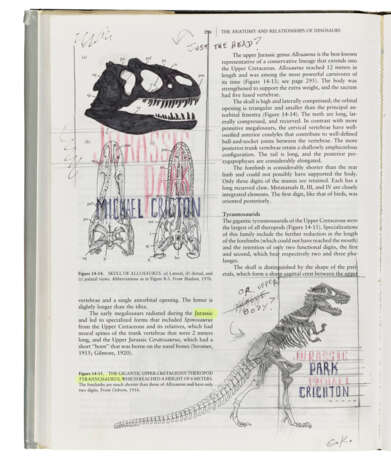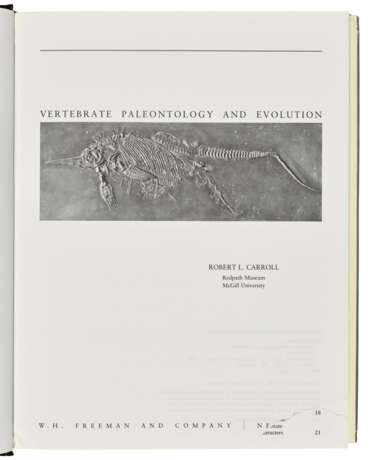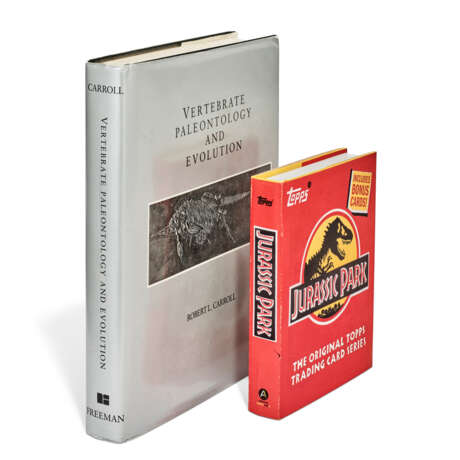ID 1353333
Lot 5 | Jurassic Park: original dust-jacket artwork
Valeur estimée
£ 20 000 – 30 000
Jurassic Park
signed 'C.K' (bottom right)
pencil, felt-tip, biro, crayon and highlighter on paper, bound in: CARROLL, Robert L (1938-2020). Vertebrate Paleontology and Evolution. New York: W.H. Freeman and Co., 1988. Large quarto. Publisher's black boards; original dust-jacket. Inscribed by the artist on front endpaper: 'Source of JP Logo', and with his business card to front pastedown.
11 x 81/2in (28 x 21cm.)
executed in 1990
The very first drawings in the development of the iconic Jurassic Park cover art.
Jurassic Park, published in 1990, is among the most famous and influential works of modern science fiction. Blending themes of genetic engineering, chaos theory, and the ethical implications of scientific advancements into a thrilling narrative, it launched a major franchise that includes sequels, films, and adaptations across media.
The artwork for the dust-jacket of the first edition, which would go on to be adapted into the lead image for the film franchise, was created by Chip Kidd in 1989. Kidd was just 25 years old and a junior designer at Alfred A. Knopf when he was entrusted with producing a jacket design for a new manuscript the publishers had received from Michael Crichton. His brief, in short, was to create for Jurassic Park an image as impactful as the cover of Jaws, which had subsequently been used for the famous film poster. Jurassic Park had also been optioned by Steven Spielberg and the enormity of Kidd’s task was not lost on the artist. Nevertheless, he set to work and in the present drawings found the basis of his famous creation - a skeletal design, stark and minimalist in black, white and red, foreshadowing the dangers inherent in the reanimation of pre-history.
For inspiration, Kidd visited the American Museum of Natural History to study their T-Rex specimen, and in the bookshop purchased what he describes as ‘a large, thick, scholarly hardcover tome called Vertebrate Paleontology and Evolution by Robert L. Carroll. As dinosaur books go, this was about as dull and unsexy as you could possibly imagine, but, it had a ton of technical black-and-white drawings in it […] These I could use as reference. So I paid for it and took it back to my office. The over 700-page book held a lot of possibilities, with diagrams of the bones of just about every conceivable kind of dinosaur. But I kept coming back to page 296 […] No matter how elegant the Brontosaurus and pterodactyls were, there was just no getting away from the T. Rex. That thing was king’.
Kidd’s archive, including all other related artworks that went into the creation of the Jurassic Park cover, is housed in the Special Collections Library at Penn State University. The present lot thus represents the only original artwork for the cover remaining in private hands.
[Sold with:]
GERANI, Gary (b. 1953). Jurassic Park: The Original Topps Trading Card Series. New York: Abrams ComicArts, 2022.
First edition, signed by Chip Kidd, of a deluxe compilation illustrating the original Jurassic Park Topps trading card series in its entirety. Containing 4 limited edition trading cards (unopened), and an afterword by Kidd describing the genesis of his iconic cover design.
Small quarto. Publisher's yellow boards; original dust-jacket; limited edition trading cards to rear pastedown.
| Style artistique: | Art moderne |
|---|---|
| Lieu d'origine: | Etats-Unis |
| Style artistique: | Art moderne |
|---|---|
| Lieu d'origine: | Etats-Unis |
| Adresse de l'enchère |
CHRISTIE'S 8 King Street, St. James's SW1Y 6QT London Royaume-Uni | |
|---|---|---|
| Aperçu |
| |
| Téléphone | +44 (0)20 7839 9060 | |
| Commission | see on Website | |
| Conditions d'utilisation | Conditions d'utilisation |





